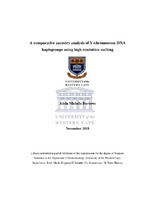| dc.contributor.advisor | Eugenia D'Amato, Maria | |
| dc.contributor.author | Michelle Burrows, Adria | |
| dc.date.accessioned | 2019-01-28T11:24:13Z | |
| dc.date.available | 2019-01-28T11:24:13Z | |
| dc.date.issued | 2018 | |
| dc.identifier.uri | http://hdl.handle.net/11394/6489 | |
| dc.description | Magister Scientiae - MSc (Biotechnology) | |
| dc.description.abstract | The objective of this study is to deduce paternal ancestry using ancestry
informative single nucleotide polymorphisms (SNPs) by means of High
Resolution Melting (HRM). This was completed by producing a multiplex system
that was designed in a hierarchical manner according to the YSNP tree. This
project mainly focused on African ancestry and was used to infer paternal
ancestral lineages on the Johannesburg Coloured population.
South Africa has a diverse population that has ancestral history from across the
globe. The South African Coloured population is the most admixed population as
it is derived from at least five different population groups: these being Khoisan,
Bantu, Europeans, Indians and Southeast Asians. There have been studies done on
the Western Cape/ Cape Town Coloured populations before but this study focused
on the Johannesburg Coloured population.
The first step was to design the multiplex system. This was done by using inhouse
SNPs. A total of seven multiplexes were designed and optimised, each
consisting of two, three or four different SNPs respectively.
A total of 143 saliva and buccal samples were collected from male Johannesburg
Coloureds. DNA was extracted from the saliva samples using an optimised
organic method. DNA was extracted from the buccal samples using an optimised
salting out method. DNA was successfully extracted from 77 of the male
samples.
A total of 69 samples were screened using Multiplex 1; of the 69 samples 56
samples were successfully screened to infer the paternal lineage of the samples.
The results show that the most frequent haplogroup of the Johannesburg male
samples was haplogroup CF (39%). The second most frequent haplogroup was
haplogroup DE (38%). Under further analysis of haplogroup DE it was seen that
37% of those samples were derived for the haplogroup E1b1b. | |
| dc.language.iso | en | |
| dc.publisher | University of the Western Cape | |
| dc.subject | Y-Chromosome, Single nucleotide polymorphism, Deoxyribonucleic acid, High resolution melting, Haplogroups, Ancestry, Multiplex | |
| dc.title | A comparative ancestry analysis of Y-chromosome DNA
haplogroups using high resolution melting | |
| dc.rights.holder | University of the Western Cape | |

